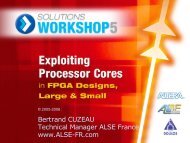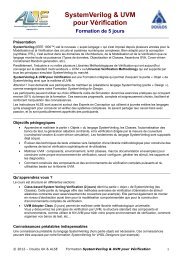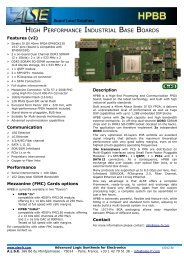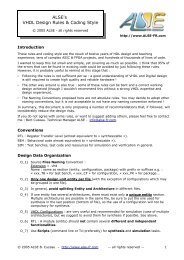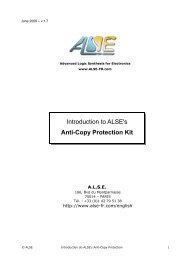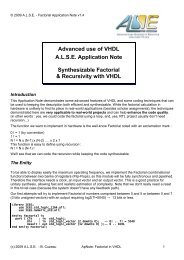learn about RS232 and how to code a UART - ALSE
learn about RS232 and how to code a UART - ALSE
learn about RS232 and how to code a UART - ALSE
You also want an ePaper? Increase the reach of your titles
YUMPU automatically turns print PDFs into web optimized ePapers that Google loves.
Physical Interface<br />
<strong>RS232</strong> is a symmetrical voltage interface (like +/- 15 Volts).<br />
More precisely, positive <strong>and</strong> negative voltages above <strong>and</strong> under given (+/- 3V) thresholds are suitable,<br />
without having <strong>to</strong> actually reach 15V. But using 0 .. 5V (eg) is absolutely not suitable !<br />
In fact the voltage region comprised between -3V <strong>and</strong> +3V is considered as “unknown”.<br />
Illustration 1: Example of transmission of character 'A' in 7-E-2 format.<br />
As we can see, the physical format m<strong>and</strong>ates the use of an interface chip (<strong>RS232</strong> line driver aka “level<br />
shifter”) <strong>to</strong> transform the usual TTL (or lower) logic signals in<strong>to</strong> positive <strong>and</strong> negative voltages, <strong>and</strong> vice<br />
versa. These chips now do not even require a negative power supply, only one <strong>to</strong> four external capaci<strong>to</strong>rs<br />
since they include a charge pump system <strong>to</strong> generate the stepped up <strong>and</strong> negative voltages.<br />
If you look at the <strong>RS232</strong> signal on the transmission line, you'll notice that a logic “1” at the logic side<br />
corresponds <strong>to</strong> -10V <strong>and</strong> a logic “0” <strong>to</strong> +10V ; there is an “inversion”. For his<strong>to</strong>rical reasons, the two levels<br />
may be referred <strong>to</strong> as “mark” for logic 0 <strong>and</strong> “space” for logic 1.<br />
A consequence of the format is that it is very easy <strong>to</strong> determine if a signal on an <strong>RS232</strong> connec<strong>to</strong>r is an<br />
input or an output : an Idle output is quite negative, while an input is typically in the indeterminate region.<br />
To transform parallel characters of the expected lengths in a serial stream <strong>and</strong> back, “<strong>UART</strong>” chips were<br />
typically used (Universal Asynchronous Receive-Transmit). We'll see you can easily design your own.<br />
Important ! For a local (short range) transmission : chip <strong>to</strong> chip, or FPGA <strong>to</strong> Micro-Controller etc, you do<br />
not have <strong>to</strong> convert <strong>to</strong> the high level voltages ! It is perfect just <strong>to</strong> stay at the logic levels.<br />
In fact, level converters are only qualified <strong>to</strong> maximum bit rates that may not be <strong>to</strong>o high. The best ones<br />
are typically qualified at 230k bauds maximum. Without level converters, you can reach higher speeds.<br />
Note that, even if you use <strong>RS232</strong> level shifters, you may just ignore the symmetrical voltages <strong>and</strong> only<br />
think of 0's <strong>and</strong> 1's in the logic level side, as we do in the rest of this document.<br />
© 2009 A.L.S.E. - B. Cuzeau ApNote: <strong>RS232</strong> Basics 3



